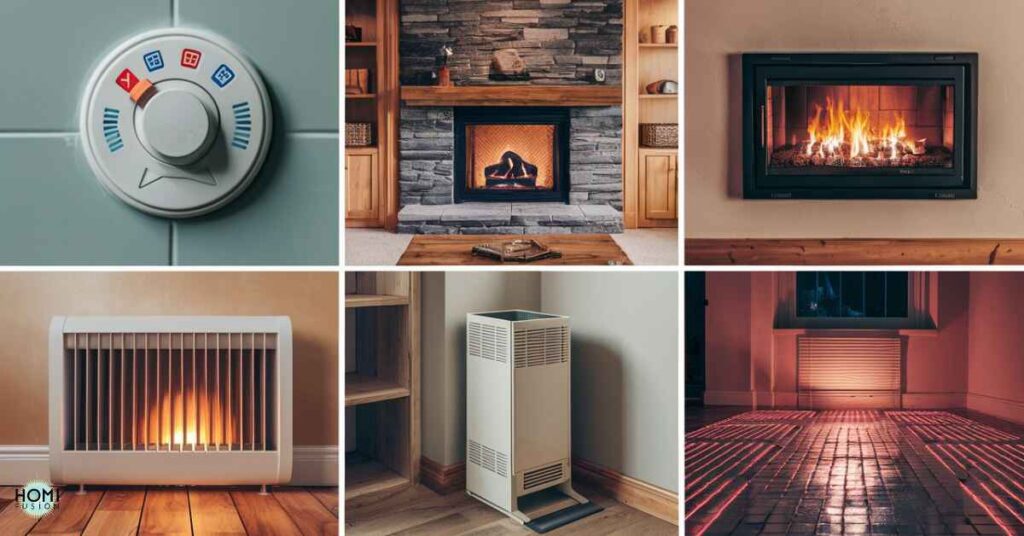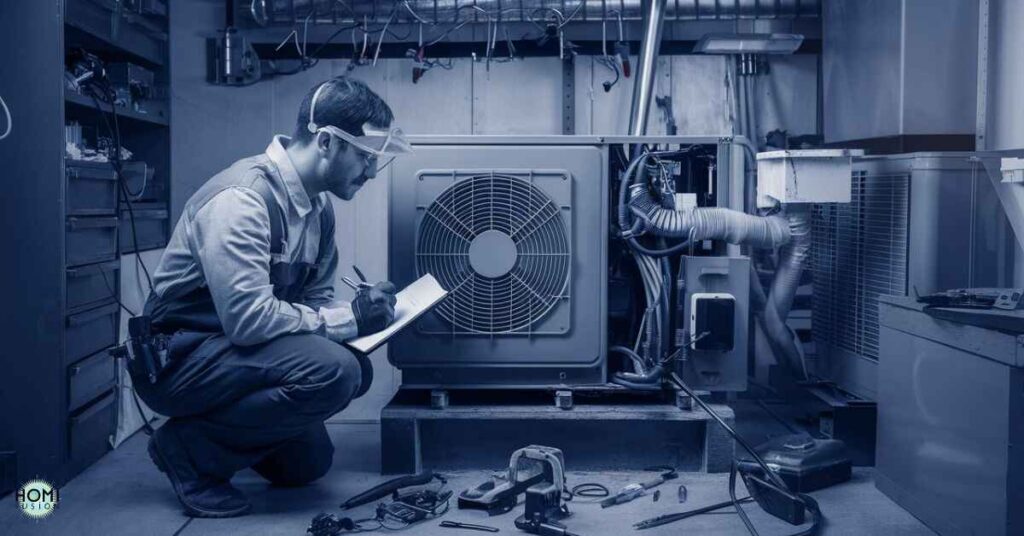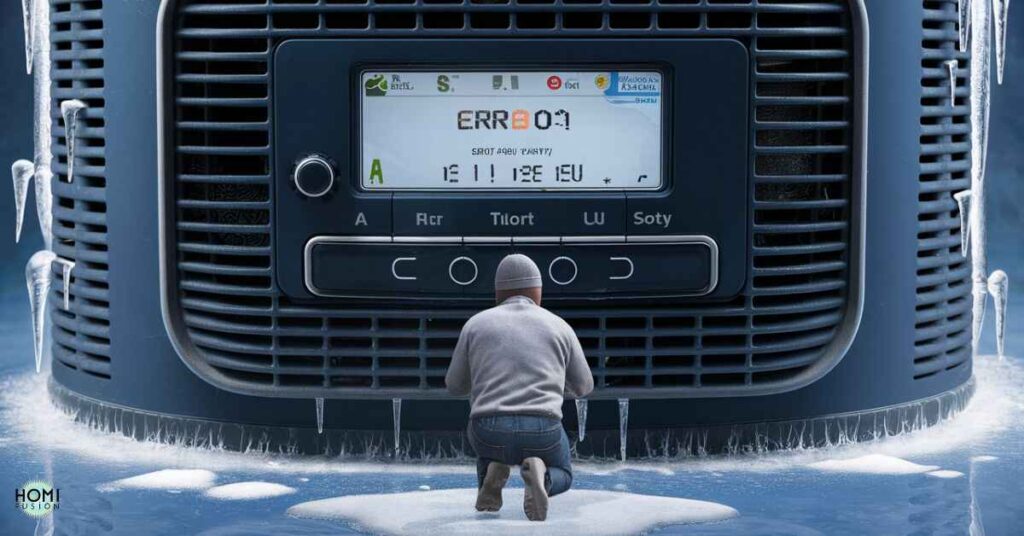As the temperatures drop, there’s nothing more frustrating than a malfunctioning heater. Don’t let the cold get you down-we’ve got the ultimate guide to help you identify and resolve common heating system problems.
From simple fixes to more complex issues, we’ll walk you through a step-by-step troubleshooting process to get your home heating system up and running again in no time.
Identifying the Type of Heating System in Your Home
Before we dive into troubleshooting, it’s crucial to understand the type of heating system installed in your home. Different systems may have unique components and potential issues. Here are some common residential heating systems:

Furnaces: These systems can be powered by gas, electricity or oil. They heat air and distribute it through ductwork.
Boilers: Boilers heat water or create steam, which is then circulated through pipes or radiators to provide warmth.
Heat Pumps: These systems transfer heat energy from outside to inside (or vice versa for cooling).
Radiant Heating Systems: These systems heat floors, walls, or ceilings directly, providing warmth through radiant heat transfer.
Understanding your system’s type and components is essential for effective troubleshooting and proper maintenance.
Basic Troubleshooting Steps for a Non-Working Heater
Before delving into system-specific issues, there are some basic troubleshooting steps you can take when your heater is not working:
Check the Thermostat Settings and Batteries: Ensure the thermostat is set to “Heat” mode and the temperature is adjusted appropriately. Also, replace the batteries if needed.
Inspect the Air Filter and Replace if Dirty: A clogged air filter can restrict airflow and cause the system to malfunction or shut down. Refer to your owner’s manual for instructions on changing the filter.
Check for Tripped Circuit Breakers or Blown Fuses: Reset any tripped breakers or replace blown fuses related to your heating system.
Ensure Fuel Supply is Adequate: For gas or oil furnaces, make sure the fuel supply is turned on and the tank is not empty.
Listen for Strange Noises or Smells: Unusual sounds or odors can indicate a more serious issue that may require professional attention.
Thermostat Troubleshooting: Common Issues and Solutions
The thermostat is the brain of your heating system, and issues with it can cause various problems. Here are some common thermostat-related issues and solutions:
Incorrect Settings: Double-check that the thermostat is set to “Heat” mode and the desired temperature is higher than the current room temperature.
Dead Batteries: Replace the batteries in your thermostat if it’s not powering on or displaying correctly.
Wiring Issues: Loose or incorrect wiring connections can prevent the thermostat from communicating with the heating system. Consult a professional if you suspect wiring problems.
Incompatible Thermostat: If you’ve recently replaced your thermostat, ensure it’s compatible with your heating system type and model.
Furnace Troubleshooting: Potential Problems and Fixes
Furnaces are one of the most common heating systems in residential homes. Here are some potential issues and fixes for furnace problems:

Ignition or Pilot Light Issues: If the furnace isn’t igniting or the pilot light won’t stay lit, there could be a problem with the gas supply, the igniter, or the thermocouple (safety device). Consult your owner’s manual or call a professional for assistance.
Blower Motor Failure: If the blower motor isn’t running, it could be due to a faulty motor, capacitor, or wiring issue. Replacing these components may be necessary.
Clogged or Dirty Burners: Over time, burners can become clogged with dirt or debris, leading to incomplete combustion and heating issues. Professional cleaning or burner replacement may be required.
Cracked Heat Exchanger: A cracked heat exchanger is a serious safety concern as it can allow carbon monoxide to leak into your home. If you suspect a cracked heat exchanger, turn off the furnace immediately and call a professional for repair or replacement.
Faulty Control Board or Wiring: The control board and wiring are essential for the furnace to operate correctly. If these components are malfunctioning, the furnace may not turn on or cycle properly. Replacement by a qualified technician may be necessary.
Boiler Troubleshooting: Diagnosing and Resolving Problems
Boilers have their own set of potential issues that can prevent them from heating your home effectively. Here are some common boiler problems and solutions:
Lack of Water Circulation: If the boiler isn’t circulating water properly, it could be due to a faulty circulator pump, air locks in the system, or a buildup of sediment. Bleeding the system or replacing the pump may resolve the issue.
Leaks: Leaks in the boiler or piping can cause water loss, leading to insufficient heating and potential water damage. Identifying and repairing leaks is crucial.
Pilot Light or Ignition Issues: Similar to furnaces, boilers may experience issues with the pilot light or ignition system. Checking the gas supply and consulting a professional may be necessary.
Low Water Pressure: If the boiler’s water pressure is too low, it can prevent the system from heating properly. Repressurizing the system or addressing any leaks may solve the problem.
Heat Pump Troubleshooting: Addressing Common Concerns
Heat pumps are efficient systems that transfer heat energy rather than generating it. However, they can still experience issues that require troubleshooting:

Refrigerant Leaks: If the refrigerant level is low due to a leak, the heat pump’s efficiency and performance will suffer. Professional leak detection and repair are necessary.
Frozen Coils: In colder climates, the outdoor coils can freeze, preventing proper heat transfer. Defrosting the coils or addressing airflow issues may resolve the problem.
Defective Reversing Valve: The reversing valve switches the heat pump between heating and cooling modes. If it’s malfunctioning, the system may not operate correctly.
Compressor Failure: The compressor is a crucial component that circulates refrigerant. If it fails, the heat pump will not function properly, and replacement may be required.
Electrical Issues: Heat pumps rely on electrical components, such as capacitors and contactors. Malfunctions in these components can cause the system to fail or operate inefficiently.
Read this blog:
Why Is It Humidity In My House?
Radiant Heating System Troubleshooting: Identifying and Resolving Issues
Radiant heating systems are unique in their design and operation, presenting their own set of potential problems. Here are some common issues and solutions:
Thermostat Issues: As with other systems, thermostat settings, batteries, and wiring can cause radiant heating systems to malfunction.
Leaks in Piping or Tubing: Leaks can lead to water or refrigerant loss, reducing the system’s efficiency and causing potential damage.
Blockages or Air Locks: Obstructions or air pockets in the piping or tubing can prevent proper fluid circulation, leading to uneven heating.
Boiler or Pump Failure: If the radiant system is connected to a boiler or circulator pump, issues with these components can impact the entire system’s performance.
When to Call a Professional HVAC Technician
While some heating system issues can be resolved through basic troubleshooting and DIY repairs, there are situations where it’s best to call in a professional HVAC (Heating, Ventilation, and Air Conditioning) technician:
Safety Concerns: If you suspect gas leaks, carbon monoxide issues, or other safety hazards, it’s crucial to involve a professional immediately.
Complex Repairs: Repairs involving major components like heat exchangers, compressors, or control boards often require specialized knowledge and tools.
Aging or Inefficient Systems: If your heating system is old or inefficient, a professional can assess whether repairs are worthwhile or if a replacement is a better long-term solution.
Recurring Issues: If you’ve attempted DIY repairs but the problem persists, it may be time to seek professional assistance for a more thorough diagnosis and resolution.
Hiring a qualified and reputable HVAC technician can ensure that your heating system is repaired safely and correctly, prolonging its lifespan and keeping your home comfortable.
Maintaining Your Heating System for Optimal Performance
Regular maintenance is key to preventing heating system breakdowns and ensuring optimal performance. Here are some maintenance tips to keep your system running smoothly:

Annual Professional Tune-Ups: Schedule an annual tune-up and inspection with a qualified HVAC technician. They will clean, lubricate, and adjust components as needed, as well as identify any potential issues before they become major problems.
Clean or Replace Air Filters: Dirty air filters can restrict airflow and cause your system to work harder, leading to decreased efficiency and potential breakdowns. Check and replace filters according to the manufacturer’s recommendations.
Clear Vents and Ductwork: Ensure that vents and ductwork are free from obstructions, such as furniture, rugs or debris. Blockages can prevent proper airflow and cause uneven heating.
Check for Leaks and Insulation: Inspect your system for any leaks in pipes, ducts, or tubing. Also, ensure that ductwork and piping are properly insulated to prevent heat loss and maximize efficiency.
Winterize Your System: Before the heating season starts, have your system inspected and prepared for the colder months. This may include cleaning the furnace or boiler, checking the flue or chimney, and ensuring proper ventilation.
By following a regular maintenance schedule and addressing minor issues promptly, you can extend the lifespan of your heating system and avoid costly repairs or replacements down the line.
Case Study: Solving a Furnace Ignition Issue
To illustrate the troubleshooting process, let’s explore a case study involving a common furnace problem: ignition issues.
The Scenario: John noticed that his gas furnace was not turning on and providing heat to his home. He checked the thermostat settings and ensured the gas supply was on, but the furnace still wouldn’t ignite.
Step 1: Check for Obvious Issues
John consulted his owner’s manual and followed the basic troubleshooting steps:
- He checked the air filter and found it to be clean.
- He ensured the circuit breaker for the furnace was not tripped.
- He listened for any strange noises or smells but didn’t detect any.
Step 2: Inspect the Ignition System
Since the basic checks didn’t reveal any issues, John focused on the ignition system:
- He located the pilot light assembly and noticed the pilot light was out.
- He followed the instructions to relight the pilot, but it wouldn’t stay lit.
Step 3: Seek Professional Assistance
At this point, John realized the issue might be more complex and could potentially involve a gas supply problem, a faulty thermocouple (safety device), or a malfunctioning igniter. To ensure his safety and properly diagnose and repair the issue, he decided to call a professional HVAC technician.
Also Read:
What Is A Furnace In A House?
The Resolution:
The HVAC technician inspected the furnace and found that the thermocouple, which monitors the pilot light and shuts off the gas supply if the flame goes out, was faulty and needed to be replaced. After replacing the thermocouple, the pilot light stayed lit, and the furnace ignited properly, restoring heat to John’s home.
This case study highlights the importance of following a systematic troubleshooting approach, consulting the owner’s manual and knowing when to seek professional assistance for complex or potentially hazardous issues.
Frequently asked questions
Why does my house heater turn on but no heat?
A house heater may turn on but produce no heat due to issues like a malfunctioning thermostat or a faulty heating element.
Why is my heater not blowing in my house?
A heater might not blow air in your house due to a clogged air filter, a malfunctioning blower motor, or a problem with the thermostat settings.
How do I reset my house heater?
To reset a house heater, check the manufacturer’s instructions as different heaters have varying reset procedures, often involving turning off the power and waiting before turning it back on.
How do I test my home heater?
You can test your home heater by setting the thermostat to a higher temperature than the current room temperature and listening for the heater to turn on and feel for warm air blowing.
How to check if a heater is broken?
To check if a heater is broken, inspect for obvious issues like burnt-out elements, strange noises, or unusual smells, and verify that the thermostat and power supply are functioning correctly.
How do you diagnose a bad heater?
Diagnosing a bad heater involves checking for common problems like faulty thermostats, clogged filters, malfunctioning heating elements, or issues with the blower motor.
Where is the heater located in a house?
The location of the heater in a house can vary, but it’s commonly found in utility rooms, basements, attics or dedicated mechanical rooms.
Conclusion
A non-working heater can be a major inconvenience, but with the right troubleshooting skills and knowledge, you can often identify and resolve the issue yourself. Start with the basics, work your way through system-specific checks, and don’t hesitate to call in a professional when needed.
Remember, regular maintenance is key to preventing heating system breakdowns and ensuring optimal performance. Schedule annual tune-ups, clean or replace air filters regularly, and address any minor issues promptly. Don’t let a malfunctioning heater leave you out in the cold. Follow our comprehensive guide to diagnose and fix common heating problems, or reach out to a trusted HVAC technician for expert assistance. Stay warm and cozy this winter.







